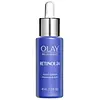What's inside
What's inside
 Key Ingredients
Key Ingredients

 Benefits
Benefits

 Concerns
Concerns

 Ingredients Side-by-side
Ingredients Side-by-side

Water
Skin ConditioningCaprylyl Methicone
Skin ConditioningCaprylic/Capric Triglyceride
MaskingDimethicone
EmollientButyrospermum Parkii Butter
Skin ConditioningGlycerin
HumectantStearyl Dimethicone
EmollientCetearyl Alcohol
EmollientSimmondsia Chinensis Seed Oil
EmollientButylene Glycol
HumectantPEG-12 Dimethicone/PPG-20 Crosspolymer
Arachidyl Alcohol
EmollientAlgae Extract
EmollientCetearyl Olivate
Borago Officinalis Seed Oil
EmollientSigesbeckia Orientalis Extract
Skin ConditioningRetinol
Skin ConditioningLactis Proteinum
Skin ConditioningHypnea Musciformis Extract
Skin ProtectingCaffeine
Skin ConditioningGelidiella Acerosa Extract
Skin ProtectingCholesterol
EmollientAcetyl Hexapeptide-8
HumectantHydrolyzed Rice Extract
Skin ConditioningSorbitan Oleate
EmulsifyingBehenyl Alcohol
EmollientOctadecene
SolventYeast Extract
Skin ConditioningTocopheryl Acetate
AntioxidantHydroxyethyl Acrylate/Sodium Acryloyldimethyl Taurate Copolymer
Emulsion StabilisingArachidyl Glucoside
EmulsifyingCaprylyl Glycol
EmollientHydroxyethylcellulose
Emulsion StabilisingTocopherol
AntioxidantAscorbic Acid
AntioxidantSodium Hyaluronate
HumectantSilica
AbrasivePolysorbate 60
EmulsifyingSorbitan Isostearate
EmulsifyingParfum
MaskingSodium Hydroxide
BufferingSodium Bisulfite
AntioxidantDisodium EDTA
BHT
AntioxidantSorbic Acid
PreservativePotassium Sorbate
PreservativePhenoxyethanol
PreservativeWater, Caprylyl Methicone, Caprylic/Capric Triglyceride, Dimethicone, Butyrospermum Parkii Butter, Glycerin, Stearyl Dimethicone, Cetearyl Alcohol, Simmondsia Chinensis Seed Oil, Butylene Glycol, PEG-12 Dimethicone/PPG-20 Crosspolymer, Arachidyl Alcohol, Algae Extract, Cetearyl Olivate, Borago Officinalis Seed Oil, Sigesbeckia Orientalis Extract, Retinol, Lactis Proteinum, Hypnea Musciformis Extract, Caffeine, Gelidiella Acerosa Extract, Cholesterol, Acetyl Hexapeptide-8, Hydrolyzed Rice Extract, Sorbitan Oleate, Behenyl Alcohol, Octadecene, Yeast Extract, Tocopheryl Acetate, Hydroxyethyl Acrylate/Sodium Acryloyldimethyl Taurate Copolymer, Arachidyl Glucoside, Caprylyl Glycol, Hydroxyethylcellulose, Tocopherol, Ascorbic Acid, Sodium Hyaluronate, Silica, Polysorbate 60, Sorbitan Isostearate, Parfum, Sodium Hydroxide, Sodium Bisulfite, Disodium EDTA, BHT, Sorbic Acid, Potassium Sorbate, Phenoxyethanol
Water
Skin ConditioningDimethicone
EmollientGlycerin
HumectantRetinol
Skin ConditioningRetinyl Propionate
Skin ConditioningNiacinamide
SmoothingPalmitoyl Pentapeptide-4
Skin ConditioningDimethiconol
EmollientC13-14 Isoparaffin
EmollientLaureth-4
EmulsifyingPolysorbate 20
EmulsifyingLaureth-7
EmulsifyingDisodium EDTA
Dimethicone Crosspolymer
Emulsion StabilisingPolyacrylamide
Titanium Dioxide
Cosmetic ColorantMica
Cosmetic ColorantDMDM Hydantoin
PreservativeIodopropynyl Butylcarbamate
Preservative
 Reviews
Reviews

Ingredients Explained
These ingredients are found in both products.
Ingredients higher up in an ingredient list are typically present in a larger amount.
Dimethicone is a type of synthetic silicone created from natural materials such as quartz.
What it does:
Dimethicone comes in different viscosities:
Depending on the viscosity, dimethicone has different properties.
Ingredients lists don't always show which type is used, so we recommend reaching out to the brand if you have questions about the viscosity.
This ingredient is unlikely to cause irritation because it does not get absorbed into skin. However, people with silicone allergies should be careful about using this ingredient.
Note: Dimethicone may contribute to pilling. This is because it is not oil or water soluble, so pilling may occur when layered with products. When mixed with heavy oils in a formula, the outcome is also quite greasy.
Learn more about DimethiconeDisodium EDTA plays a role in making products more stable by aiding other preservatives.
It is a chelating agent, meaning it neutralizes metal ions that may be found in a product.
Disodium EDTA is a salt of edetic acid and is found to be safe in cosmetic ingredients.
Learn more about Disodium EDTAGlycerin is already naturally found in your skin. It helps moisturize and protect your skin.
A study from 2016 found glycerin to be more effective as a humectant than AHAs and hyaluronic acid.
As a humectant, it helps the skin stay hydrated by pulling moisture to your skin. The low molecular weight of glycerin allows it to pull moisture into the deeper layers of your skin.
Hydrated skin improves your skin barrier; Your skin barrier helps protect against irritants and bacteria.
Glycerin has also been found to have antimicrobial and antiviral properties. Due to these properties, glycerin is often used in wound and burn treatments.
In cosmetics, glycerin is usually derived from plants such as soybean or palm. However, it can also be sourced from animals, such as tallow or animal fat.
This ingredient is organic, colorless, odorless, and non-toxic.
Glycerin is the name for this ingredient in American English. British English uses Glycerol/Glycerine.
Learn more about GlycerinRetinol is a gold-standard ingredient for anti-aging. It is a form of Vitamin A and belongs to the class of retinoids that also includes tretinoin.
Why is retinol famous?
It has the most scientific studies backing up its skin benefits out of all the non-prescription ingredients.
Retinol is proven to:
This is why retinol is effective at removing wrinkles, fading dark spots, treating acne, and reducing the appearance of pores.
Studies show retinol is less effective when exposed to UV. Be sure to look for appropriate packaging to keep your retinol potent (similar to Vitamin C).
Using retinol or any retinoids will increase sun-sensitivity in the first few months. Though studies show retinoids increase your skin's natural SPF with continuous use, it is best to always wear sunscreen and sun-protection.
We recommend speaking with a medical professional about using this ingredient during pregnancy.
Retinol may cause irritation in some people, so be sure to patch test. Experts recommend 'ramping up' retinol use: start using this ingredient once a week and work up to using it daily.
Read about Tretinoin
Learn more about RetinolWater. It's the most common cosmetic ingredient of all. You'll usually see it at the top of ingredient lists, meaning that it makes up the largest part of the product.
So why is it so popular? Water most often acts as a solvent - this means that it helps dissolve other ingredients into the formulation.
You'll also recognize water as that liquid we all need to stay alive. If you see this, drink a glass of water. Stay hydrated!
Learn more about Water